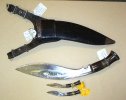I have two CS khukuri. The Gurkha in SK5 and an old Light Terrain Chopper (LTC) in Carbon V. They are both superb blades. My LTC, being 1/8" thick and 17 oz., is probably my most useful large blade. It is shaped like the current Kukri Machete model, slices grass like a razor, and actually bites hard wood deeper than my other choppers. It's not a chopper, per se, as it doesn't blast wood chunks when chopping, but for my nothing-like-a-pine-forest locale, it's perfect. The heavier (23 oz.) Gurkha, while not a machete, handles machete tasks quite well. It also chops very well, but is flat ground and doesn't clear as much wood during a chop as a thick, convex blade. Both of these blades are light and very well balanced. I've been very pleased with the strength and edge holding ability of both blades. They handle the hardest wood I have available, seasoned oak and mesquite (this ain't pine

), without any edge deformation and actually retain their sharpness extremely well. The handles work great for me except when chopping. They are a tad small, but I did a paracord wrap on my Gurkha and it feels much better. The handles can't compete with the handle on my Tirtha WWII, but the Kraton/rubber is tough and will not slip during use. I love my CS khuks. They don't have the spirit of the hand made khuks, but they are incredible tools. I have seriously abused the LTC and it's as servicable today as it was when I bought it in the early/mid 1990's. Take care.







